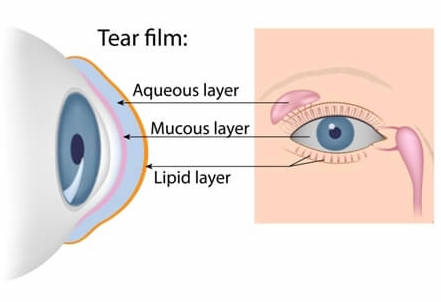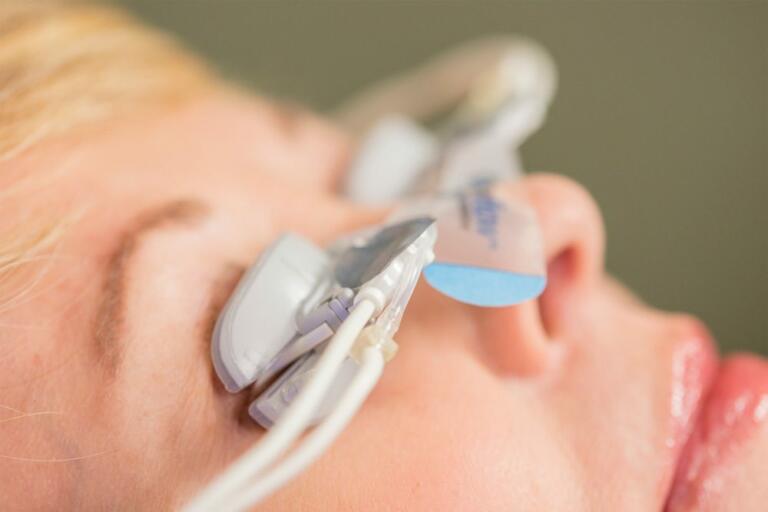Do you ever feel like something is stuck in your eye, but you can’t flush it out? Are your eyes stinging, burning, or appearing noticeably red after a day’s work on your computer?
Do your eyes often feel uncomfortable or “sticky?” If you are familiar with any or all of these complaints, dry eye syndrome could be to blame!
According to the American Academy of Ophthalmology, dry eye syndrome is a common eye condition that affects an estimated 20 million people in the US. Keep reading to learn more about dry eye syndrome and whether you could have it!
What is Dry Eye Syndrome?

Dry eye syndrome occurs when your eyes cannot produce an adequate volume of tears or your eyes produce tears that are poor in quality. Poor-quality tears do not contain enough naturally occurring lubricants that keep eyes moist.
Healthy tears are composed of three layers: a lipid (oily) layer, an aqueous (watery) layer, and a mucin (mucus) layer. These three layers work together to ensure the surface of your eyes stays moist and clear.
Adequate, high-quality tear production is vital to keeping your eyes healthy. Your eyes need tears not just to keep them lubricated but also to clear away potential irritants. This ensures the surface of your eye is smooth, allowing for optimal visual clarity.
What Causes Dry Eye Syndrome?
There are several different causes of dry eye syndrome. One of the most common causes is aging. With age, your eyes produce less of the high-quality tears that ensure comfortable vision.
An increasingly common cause of dry eye syndrome is spending extended amounts of time staring at an electronic screen. These include things like a computer or tablet. When you look at a screen for a prolonged period, you tend to blink less and reduce your blink rate. When this occurs, it prevents your eyes from maintaining healthy moisture levels.
Your environment can also cause dry eye syndrome. If you live in a windy or hot climate with air conditioning, you’re more likely to develop dry eye syndrome.
Some less common causes of dry eye syndrome include:
- Contact lens use
- Certain medications
- Meibomian gland dysfunction
- Chronic medical conditions or diseases
- Corneal injuries
What are the Symptoms of Dry Eye Syndrome?

Common symptoms associated with dry eye syndrome include:
- Feeling like something is permanently stuck in your eye
- Eyes that feel sticky even after blinking
- Noticeable redness that is long-lasting
- A newly heightened sensitivity to windy or smoky environments
- Blurred vision
- Eye fatigue while looking at a screen or after looking at a screen
- Difficulty wearing contact lenses
- Excessively watery eyes
- Dry eyes
Excessively watery eyes may seem like an unusual symptom for a condition caused by chronically dry eyes. However, when your eyes are chronically dry, they will try to compensate by overproducing tears.
What are the Risks of Untreated Dry Eye Syndrome?
Leaving dry eye syndrome untreated can lead to serious complications with keeping your eyes healthy. When your eyes are chronically dry, they are less protected from the germs that cause eye infections. You’re also at a higher risk of damage to the surface of your eye.
Untreated dry eye syndrome can also lead to eye conditions that threaten vision. These conditions include eye inflammation, corneal abrasions, and corneal ulcers.
How is Dry Eye Syndrome Diagnosed?
If you are experiencing the symptoms of dry eye syndrome, it’s best to schedule a comprehensive eye exam. Doing this allows your ophthalmologist to diagnose the condition. At Batra Vision Medical Group, we can check the quality of your tears right in our office. We use the advanced TearLab Osmolarity System.
This technology allows us to offer our patients the most accurate dry eye syndrome diagnoses. The TearLab Osmolarity System needs just a nanoliter of your natural tears to analyze their composition, allowing our team to get more accurate results and offer the most effective treatment options.
How is Dry Eye Syndrome Treated?

Treatments for dry eye syndrome depend on both the cause of your dry eyes and the severity of your condition. For mild cases of dry eye syndrome, your eye doctor may recommend over-the-counter or prescription eyedrops to increase the moisture levels in your eyes.
A surgical procedure may be more effective for more advanced cases of dry eye syndrome. These procedures include closing the tear drainage canals within the eye and inserting punctal plugs to reduce tear drainage.
We can offer our dry eye syndrome patients LipiFlow treatments at Batra Vision Medical Group. These treatments involve the application of gentle, consistent heat and massage to unblock the meibomian glands and ease dry eye syndrome symptoms.
If you are routinely experiencing eye discomfort, you may wonder if you have dry eye syndrome. The best way to find out is by scheduling a comprehensive eye exam at Batra Vision Medical Group!
We can offer you an accurate diagnosis using advanced technology and effective treatment options that will have you seeing comfortably again in no time! Take the next step towards improving your vision by requesting an appointment today at Batra Vision in San Leandro, CA!

 Follow Us!
Follow Us!